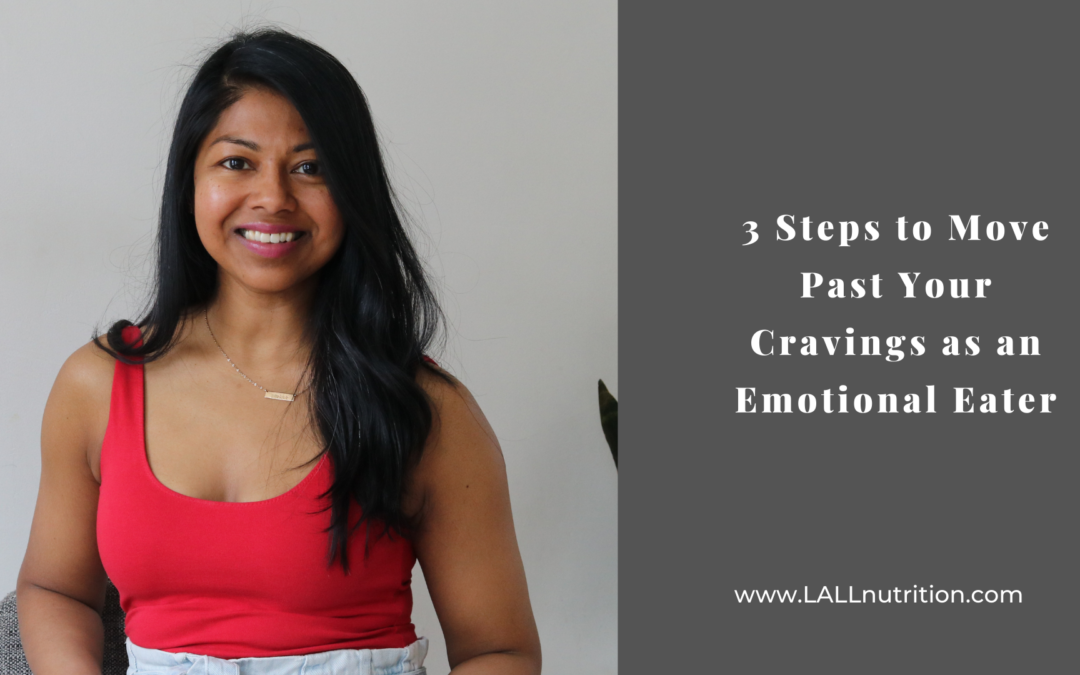Hello love,
Today I want to share with you more about cravings and three steps to moving past your cravings as an emotional eater. This comes up a lot with clients and it was my experience too. I had a lot of cravings as an emotional eater. Cravings are a great way to see if you are emotionally eating as well.
Emotional Eating
Emotional eating is when we use food to cope with our emotions. And that sounds pretty simple, but sometimes it’s a bit nuanced, especially when it comes to cravings. So we know we’re having more of an emotional eating episode when we are constantly craving the same food and the craving comes on pretty strongly. I’ll share a bit more on that later.
I’m going to share with you a bit more about why this might be happening and how to navigate it. I also wanted to share with you what cravings could mean. So sometimes cravings, specific cravings for certain foods, they can help us see what kind of emotion is there or how we want to feel. So it’s a great way to become more aware of our cravings and what they’re meaning.
More on Cravings
So so cravings that come up for me in the past would be for cookies or cake or chocolate and not so much salty, but more sweet.
Each kind of craving has an emotion that goes along with it. So I’m going to share with you some of those.
- So if you find that you’re craving sweet, you might want to feel happy. You want to feel comforted. Maybe you’re rewarding yourself.
- If you are craving chocolate, you might need more love in your life, more self-love, because there’s a compound in chocolate that is the same as love.
- If you’re if you’re craving cheese or dairy products, what they do, they have compounds that interact with our brain and alter our mood. And so you might just need a change of state.
- If you are craving fat, you may be feeling empty or feeling loneliness. And you don’t want to feel like that. You want to feel comforted. So fat creates a layer around us. If you think about if we it’s almost like padding. It’s like putting a fuzzy blanket around us and kind of comforting.
- If it’s salty or crunchy foods it might mean you have anger or frustration or stress. So more the anger and frustration might be the crunchy foods you want to crunch down. Salty, salty foods are when you’re stressed. We need those minerals in our body.
- If you’re craving carbohydrates, you might need to be comforted more. You may need an energy boost.
- Spicy foods might mean you need more excitement in your life or you want to feel like sated.
- And then finally coffee. It stimulates you and it’s sort of an energy boost.
If you have a certain craving for these foods, they can give us an indication of what you might be needing or missing in your life.
But if you just say, “oh, I’m going to add more excitement into my life because I’m craving spicy foods” that’s kind of a bandaid solution. There may be a nuance for you.
So I’m going to share with you more about how we can work through our cravings to see what’s really at the root cause. For me, my goal is always to get to the root and resolve it at the root so you don’t ever have to keep working on your emotional eating.
As emotional eater we have these certain foods or we crave them or we binge on them to change the way we’re feeling. We want to cope and our brains have created these coping patterns. We automatically go towards the food without noticing the emotion underneath.
I’m going to share with you three steps to work through the cravings to see what’s really underneath it.
Step 1: True vs. Emotional Hunger
The first thing I teach to all clients is to start noticing the difference between true and emotional hunger. So every time a craving comes up, you want to see which one you are having.
If you want more details on telling the difference, you can download the “What Are Your Truly Hungry For?” Guide HERE.
So true hunger, physical hunger is in your stomach. You notice it a few hours after you last ate. The hunger comes on more slowly. It’s in your stomach, it’s growing. Whereas emotional hunger comes on very quickly, you need to have food right away and you need a specific food.
So as cravings come on, you start to notice “is this an emotional hunger or a true hunger?” you have two different paths to go down. So if you realize “oh, I am truly hungry and I keep getting this craving, I don’t know why I always crave these foods and they’re always processed, but I am really hungry”. You have to look at the second step is looking at how do you nourish yourself throughout the day.
Step 2 True Nourishment + Strategic Digestion
Are you nourishing yourself? Are you giving yourself enough food or are you hungry? So the thing with diet culture is that we’re taught to control our emotional eating. We’re taught that we’re out of control with our hunger so we need to eat a certain way, certain calories, cut out certain foods. And so what we do is we deplete ourselves, our bodies are in a restriction mode.
So our body is really hungry. It’s looking for nourishment. We need to truly nourish our body, which means putting in the right foods, but also being strategic about our digestion.
I work through this with clients in my program, the Emotional Eating Evolution Program, where we create the foundation of true nourishment and strategic digestion because it’s so important we have to have this foundation set to see where the cravings are coming from. Maybe you’re not eating enough or giving your body the right nutrients to support it.
So it’s craving it’s asking for more. So that is the second step. So if you realize it’s a physical hunger, you have to look at how well are you nourishing your body? Are you eating enough, are you eating enough quality foods? Are you digesting it so you nourish your body?
If you notice you’re still having emotional eating come up even after you’ve been nourishing your body. then we look at the emotion underneath the emotional eating. Sometimes by shifting the way we nourish our body, we cut out some of the cravings. So not every craving is emotional, but if emotional eating still comes up then we look at the emotion underneath. We want to have the foundation of really nourishing the body before we jump into processing the emotions.
Step 3 Resolving the Emotions
The next step, the third step would be to process the emotions under the emotional eating, under the craving. This is what I teach clients and what we do together are somatic meditations to get to the root of the craving. We’re looking for the root of why you start emotionally eating + where is this pattern coming from. We work through it. We process the emotion, we resolve it, and we really get to the root and see what the true need is.
So the need is not food. There’s a deeper need. If we go back to the spick example, maybe it’s excitement but in a specific way for you. Let’s say if you’re craving spicy foods there’s something underneath that is missing for you. But it’s going to be specific for you.
When we do the meditations, you ask internally what is unresolved in you that you need to resolve.
What if you are emotionally hungry?
So let’s say you realize that you are emotionally hungry, what happens is that you just go to step number three and you process through the emotions. You get to the root of it and what’s going on emotionally for you under that craving.
So you can see it’s a little bit nuanced. In my program, The Emotional Eating Evolution Program we work through this in a step by step process. We work through the steps above; knowing when you’re truly hungry versus emotionally hungry, truly nourishing the body and then we work through the emotions, under the emotional eating.
So if this is something that’s resonating with you and you need support moving through your cravings then the emotional eating evolution program is probably a really great fit for you. I’d love to invite you to book in an Emotional Eating Assessment Call here to see if it can if the program can support you and if it is a good fit. It bridges the gap from where you’re at to where you want to be.So that’s there for you if you are looking for more support and a step by step plan.
To clarity,
Michelle
Certified Holistic Nutritionist + Emotional Eating Expert.


